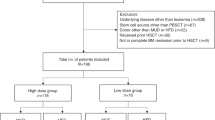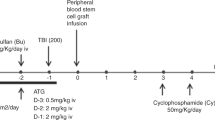Abstract
Antithymocyte globulin (ATG) is commonly used in allogeneic haematopoietic stem cell transplantation (HSCT). Little information is available, however, as to the optimal protocol for use and the side-effects occurring if ATG is administered in high daily doses (10–30 mg/kg). We report our experience with ATG Fresenius (ATG-F) in conditioning for allogeneic HSCT. During a period of 3 days, 47 patients received doses between 10 and 30 mg/kg either over 4 h preceded by 1–1.5 mg/kg prednisolone 30 min before the start of ATG-F (protocol A) or alternatively, over 12 h with 3–4 mg/kg prednisolone being administered before and 6 h after start of ATG (protocol B). During treatment with ATG-F, the side-effects observed included inflammation, disseminated intravascular coagulation, hyperdynamic circulation and renal dysfunction. Although these complications caused substantial morbidity, they were reversible within a few days. Side-effects were significantly more severe in patients treated according to protocol A than in those treated according to protocol B. As prolonged infusion of ATG-F does not reduce T cell clearance due to the long half-life of ATG-F, and since less cytokine release during conditioning might have beneficial long-term effects, we recommend administering ATG-F over 12 h preceded by high-dose steroid treatment.
This is a preview of subscription content, access via your institution
Access options
Subscribe to this journal
Receive 12 print issues and online access
$259.00 per year
only $21.58 per issue
Buy this article
- Purchase on Springer Link
- Instant access to full article PDF
Prices may be subject to local taxes which are calculated during checkout


Similar content being viewed by others
References
Kolb HJ, Thierfelder S, Baumann P, Balk O . Conditioning recipients of hematopoietic cells with antilymphocyte serum (ALS) and partial irradiation Rev Europ Etudes Clin Biol 1971 16: 810 814
Kolb HJ, Storb R, Graham TC et al. Antithymocyte serum and methotrexate for control of graft-versus-host disease in dogs Transplantation 1973 16: 17 23
Fresenius HemoCare Immune Therapy GmbH, Gräfelfing, Germany. ATG-Fresenius S. Gebrauchsinformation und Fachinformation
Glucksberg H, Storb R, Fefer A et al. Clinical manifestations of graft-versus-host disease in human recipients of marrow from HLA-matched sibling donors Transplantation 1974 18: 295 304
Reinhart K, Karzai W, Meisner M . Procalcitonin as a marker of the systemic inflammatory response to infection Intens Care Med 2000 26: 1193 1200
Grosse-Wilde H, Jakubowski HD, Eigler FW, Kuwert EK . In vitro immunoresponsiveness in recipients of cadaveric renal allografts during ATG therapy Proc Eur Dial Transplant Assoc 1981 18: 481 485
Eiermann TH, Lambrecht P, Zander AR . Monitoring antithymocyte globulin (ATG) in bone marrow recipients Bone Marrow Transplant 1999 23: 779 781
Frickhofen N, Heit W, Raghavachar A et al. Immunosuppressive therapy in panmyelopathy. Experiences with various forms of therapy in 42 patients Deut Med Wochenschr 1987 112: 535 541
Titiz MI, Turkmen F, Yegenaga I et al. Abdominal pain that mimics acute appendicitis caused by an ATG overdose in a kidney transplant recipient Transplant Int 1994 7: 385
Hoffman T, Tripathi AK, Lee YL et al. Stimulation of human monocytes by anti-CD3 monoclonal antibody: induction of inflammatory mediator release via immobilization of Fc receptor by adsorbed immunoglobulin and T-lymphocytes Inflammation 1992 16: 571 585
Holler E, Kolb HJ, Mittermüller J et al. Modulation of acute graft-versus-host disease after allogeneic bone marrow transplantation by tumor necrosis factor alpha (TNF alpha) release in the course of pretransplant conditioning: role of conditioning regimens and prophylactic application of a monoclonal antibody neutralizing human TNF alpha (MAK 195F) Blood 1995 86: 890 899
Rosenbloom AJ, Pinsky MR, Bryant JL et al. Leukocyte activation in the peripheral blood of patients with cirrhosis of the liver and SIRS. Correlation with serum interleukin-6 levels and organ dysfunction JAMA 1995 274: 58 65
Vervloet MG, Thijs LG, Hack CE . Derangements of coagulation and fibrinolysis in critically ill patients with sepsis and septic shock Semin Thromb Hemost 1998 24: 33 44
Lee WL, Downey GP . Coagulation inhibitors in sepsis and disseminated intravascular coagulation Intens Care Med 2000 26: 1701 1706
Chatenoud L, Legendre C, Ferran C et al. Corticosteroid inhibition of the OKT3-induced cytokine-related syndrome-dosage and kinetics prerequisites Transplantation 1991 51: 334 338
Buttgereit F, Wehling M, Burmester GR . A new hypothesis of modular glucocorticoid actions: steroid treatment of rheumatic diseases revisited Arthritis Rheum 1998 41: 761 767
Cronin L, Cook DJ, Carlet J et al. Corticosteroid treatment for sepsis: a critical appraisal and meta-analysis of the literature Crit Care Med 1995 23: 1430 1439
Pinsky MR, Vincent JL, Deviere J et al. Serum cytokine levels in human septic shock. Relation to multiple-system organ failure and mortality Chest 1993 103: 565 575
Thijs LG, Hack CE . Time course of cytokine levels in sepsis Intens Care Med 1995 21: S258 S263
Sorensen JB, Andersen MK, Hansen HH . Syndrome of inappropriate secretion of antidiuretic hormone (SIADH) in malignant disease J Intern Med 1995 238: 97 110
Assicot M, Gendrel D, Carsin H et al. High serum procalcitonin concentrations in patients with sepsis and infection Lancet 1993 341: 515 518
AlNawas B, Krammer I, Shah PM . Procalcitonin in diagnosis of severe infections Eur J Med Res 1996 1: 331 333
Brunkhorst FM, Eberhard OK, Brunkhorst R . Discrimination of infectious and noninfectious causes of early acute respiratory distress syndrome by procalcitonin Crit Care Med 1999 27: 2172 2176
Sachse C, Machens HG, Felmerer G et al. Procalcitonin as a marker for the early diagnosis of severe infection after thermal injury J Burn Care Rehabil 1999 20: 354 360
Schwenger V, Sis J, Breitbart A, Andrassy K . CRP levels in autoimmune disease can be specified by measurement of procalcitonin Infection 1998 26: 274 276
Sabat R, Hoflich C, Docke WD et al. Massive elevation of procalcitonin plasma levels in the absence of infection in kidney transplant patients treated with pan-T-cell antibodies Intens Care Med 2001 27: 987 991
Holler E, Kolb HJ, Moller A et al. Increased serum levels of tumor necrosis factor alpha precede major complications of bone marrow transplantation Blood 1990 75: 1011 1016
Author information
Authors and Affiliations
Rights and permissions
About this article
Cite this article
Pihusch, R., Holler, E., Mühlbayer, D. et al. The impact of antithymocyte globulin on short-term toxicity after allogeneic stem cell transplantation. Bone Marrow Transplant 30, 347–354 (2002). https://doi.org/10.1038/sj.bmt.1703640
Received:
Accepted:
Published:
Issue Date:
DOI: https://doi.org/10.1038/sj.bmt.1703640
Keywords
This article is cited by
-
Overt gastrointestinal bleeding following haploidentical haematopoietic stem cell transplantation: incidence, outcomes and predictive models
Bone Marrow Transplantation (2021)
-
Rabbit ATG/ATLG in preventing graft-versus-host disease after allogeneic stem cell transplantation: consensus-based recommendations by an international expert panel
Bone Marrow Transplantation (2020)
-
Cytokine release syndrome
Journal for ImmunoTherapy of Cancer (2018)
-
Anti-thymocyte globulin-induced hyperbilirubinemia in patients with myelofibrosis undergoing allogeneic hematopoietic cell transplantation
Annals of Hematology (2016)
-
Population Pharmacokinetic Modeling of Thymoglobulin® in Children Receiving Allogeneic-Hematopoietic Cell Transplantation: Towards Improved Survival Through Individualized Dosing
Clinical Pharmacokinetics (2015)



